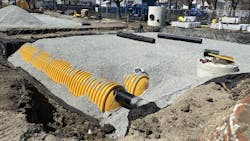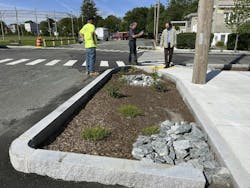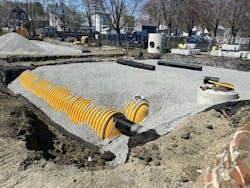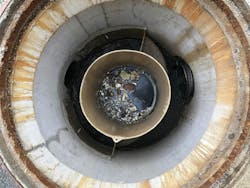Pre-treatment is pro-tection: Designing green stormwater infrastructure for the long term
Green stormwater infrastructure (GSI), like rain gardens, bioretention cells, and others, has been adopted by the private and public sectors to improve watershed health by infiltrating runoff. One key consideration for a long-lasting and effective GSI practice is pretreatment measures. Sediment accumulates quickly in treatment structures, so having an easily accessible place to facilitate removal will protect the more sensitive elements of the practice, like the void space of crushed stone. A poorly designed GSI measure could fail within a matter of a couple years, wasting hundreds of thousands of dollars worth of investment and doing nothing to improve watershed health. Pretreatment can play a big role in protecting structures long-term.
Pollutants — they have to go somewhere
Pollutant loads in stormwater runoff vary based on land use and surface characteristics. Roads and parking lots contribute pollutants including sediment, chloride (i.e., road salt), nutrients, and heavy metals like lead and zinc. Of these pollutants, sediment has the greatest potential to impede GSI measures. Chloride can also pose an acute risk to plant health depending on the species chosen.
In an urbanized area with a higher percentage of roadways and parking areas, the concentration of total solids (settleable solids, suspended solids, and dissolved solids) can range from 256 mg/L to 2,810 mg/L (Bannerman et al (1996). Quality of Wisconsin Stormwater, 1989-94, 13). This can result in over 1,000 pounds of sediment being generated per acre per year for an area that is 40% impervious.
Uncontrolled sediment has the potential to clog pipes, foul stone beds, and pile up in landscaped planting areas. For a small rain garden of 100 square feet collecting an acre of drainage area with 40% impervious surface, it is realistic to expect about an inch of sediment deposition per year based on the pollutant generation rates above. By capturing as much of this sediment as possible before it enters a sensitive planting area, the amount of labor needed to clean up each year is reduced significantly.
Good GSI designs provide dedicated storage areas for trash, road sand, leaf matter, and other solid waste that can be removed as part of a regular maintenance program. By adding pretreatment measures upstream of a GSI practice, a significant percentage of sediment (up to 50% in some cases) can be captured.
A variety of pretreatment choices
Pretreatment devices vary widely depending on the application. For surface-level treatment, devices like rain gardens, vegetated swales, or forebays are effective. For subsurface structures like infiltration trenches, deep sump catch basins or proprietary treatment devices are a good choice.
With so many proprietary devices on the market, it can be hard to tell which ones are more effective than others. There are several third parties that do independent research to provide an objective analysis. The Washington State Technology Assessment Protocol – Ecology[1] (TAPE) program and the New Jersey Corporation for Advanced Technology[2] (NJCAT) are two entities that have been used as a standard for evaluation by several state regulatory agencies.
Design considerations
Keep in mind that pretreatment is not intended to capture everything. Fine-grain sediment (e.g., silts) will pass right through and enter the GSI practice. A good design protects infiltrative media, whether that is the washed crushed stone of an infiltration gallery or the carefully specified bioretention soil mix.
Perforated pipes in stone should not dead-end with a cap buried into the ground; a cleanout should be installed at the end. That way, if the pipe clogs in the future, a pressure washer can flush out the line. Filter fabric is very useful to separate different types of material, especially for stone with a lot of void space. A non-woven geotextile should be installed in a trench before backfilling with clean washed stone. A layer of fabric on top of a stone bed can be used to create a sacrificial area; silt accumulates on top of the fabric and can be excavated during maintenance activities. Finally, if the project is in an area where road salt is used, carefully consider the types of plantings for the GSI practice to make sure they are salt-tolerant.
Green infrastructure is not typically intended to control flows from larger (e.g., 1-year, 10-year, and 100-year storm events) events, they are best at treating the smaller storms that occur 90% of the time (e.g., 1” of rain or less). If a large amount of runoff enters a rain garden, the high velocity could wash away mulch and plantings, leaving a thick mat of sediment. Designing GSI as off-line practices will keep the larger storms from impacting those structures. Forebays with overflow spillways or deep sump catch basins with a second discharge pipe are examples of how to divert high flows away from GSI.
Finally, put the GSI practice in context with its contributing watershed to help decide what design elements to include. For example:
- Is it a rain garden that gets fed by roof leaders only? Sediment loading is less of a concern and pretreatment may not be as critical.
- Is it near a highway that uses salt and sand in the winter? Consider an oversized pretreatment practice to accommodate the higher sediment load. Select salt-tolerant species appropriate for your climate such as goldenrod.
Maintenance
Many jurisdictions mandate in their stormwater regulations the establishment of an operations and maintenance plan once the structure is installed. Regular inspections are a common requirement, logging the depth of sediment and taking photographs of the site conditions. Frequent check-ins like this help determine the rate of deposition and inform decisions on when it is necessary to clean out the structures.
If there are no regulatory requirements for the installation of your GSI practice, there is a decision to be made on maintenance. Is it more economical to spend time and resources regularly maintaining pretreatment practices, or just wait for the structure to stop working and rebuild it completely? Here are some questions to consider:
- Are there maintenance staff or reliable volunteers to do the work each year?
- Are the aesthetic features a key feature that stakeholders wish to keep at a high level?
- Is the right equipment available to perform the maintenance?
- Are there upcoming larger construction projects in the area that could incorporate rehabilitation or retrofitting in the future?
Each type of pretreatment device has unique maintenance needs that require different amounts of labor, materials, and specialized equipment. What tools you have on hand to do maintenance work can also feed into the decision-making process for selecting a pretreatment device.
Conclusion
GSI features collect a significant amount of sediment each year; failing to manage it will reduce the water quality benefits these features provide. Understanding this at the start of the design process, involving those who will be responsible for long-term care, will result in devices that are aesthetically pleasing while being effective at keeping our streams and rivers free of pollutants.
References
[1] Washington State Department of Ecology, Emerging stormwater treatment technologies (TAPE), Guidance & Technical Assistance, accessed March 24, 2025, https://ecology.wa.gov/Regulations-Permits/Guidance-technical-assistance/Stormwater-permittee-guidance-resources/Emerging-stormwater-treatment-technologies
[2] New Jersey Corporation for Advanced Technology, Technology Verification Database - Stormwater Technologies: Laboratory Verified and NJDEP Certified, accessed March 24, 2025, http://njcat.org/verification-process/technology-verification-database.html
About the Author

Shane Mullen
Shane Mullen, PE, CPESC is a Technical Specialist II with Weston & Sampson in Waterbury, Vermont.





